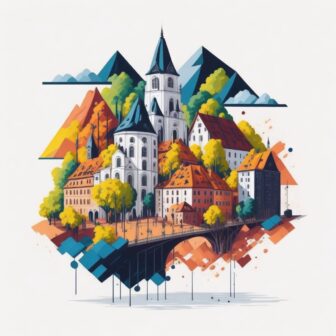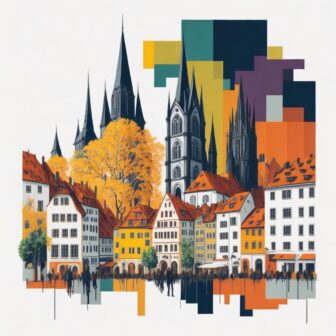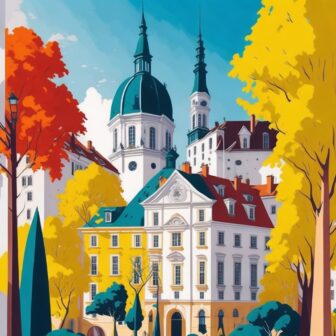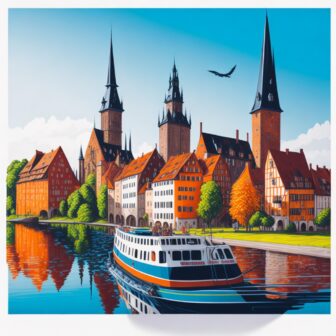20 Best Places to Visit in Lübeck in 2023
Experience Lübeck’s best landmarks, sights, and attractions. Uncover the allure of Lübeck, a city where history intertwines with beauty. Marvel at Gothic landmarks like the Holstentor, while the UNESCO-listed Old Town enchants with its medieval charm.
Immerse yourself in cultural treasures at the Marienkirche and museums, and bask in the serenity of Lübeck Bay’s sandy beaches. Treat your taste buds to delectable marzipan and savor a cup of coffee by the Trave River. Lübeck beckons, offering an extraordinary adventure filled with wonders that will leave a lasting impression.
1. Altstadt (Old Town)
Indulge in the captivating allure of Lübeck’s UNESCO World Heritage-listed Altstadt (Old Town), a place that lured us irresistibly to this enchanting city. The picturesque charm captured in photographs is surpassed by the actual experience itself.
Exploring the Old Town is undoubtedly a must-do when in Lübeck, and it claims the top spot on my list of recommended activities. The meticulously restored 13th to 15th-century buildings beckon you to wander in any direction your heart desires, as each turn reveals a delightful surprise. Leave the map behind and embrace the joy of getting pleasantly lost, knowing that it’s all part of the adventure.
Immerse yourself in the hidden courtyards (more details below), admire the stately merchant houses and warehouses that bear witness to the city’s trading significance, and delve into the world of museums and soaring steeples. Relish in the local cuisine, revel in the beauty of half-timbered houses, and allow yourself to be captivated by the myriad of other experiences that await you.
Lübeck’s Old Town, nestled on a small island and embraced by the Trave River, is a visual treat from every angle. While wandering through this living museum, take your time to absorb the essence of this remarkable place, dedicating a couple of hours to savor its delights.
2. Holstentor (Holsten Gate)
The iconic Holstentor, an emblematic symbol of Lübeck, stands proudly as the city’s most renowned landmark. Constructed in 1464, this imposing structure has achieved widespread fame throughout Germany. Originally one of the four medieval gates leading to the Old Town, only two gates remain today, with the Holstentor reigning supreme.
As you make your way into Lübeck, whether by train or otherwise, allow this magnificent gate to serve as your gateway to the captivating Old Town. The experience is heightened as you pass through its historic archways.
Having undergone two reconstructions, the Holstentor retains its majestic appearance, with its twin towers leaning toward each other, creating an illusion of inward sagging, attributed to its unstable foundation.
Step inside the towers to explore the Museum Holstentor, where you can immerse yourself in the fascinating history of the gate, as well as the illustrious past of Lübeck as a Hanseatic and Free Imperial City.
3. Petrikirche (Church Of St Peter)
Situated in close proximity to the Holstentor, the Petrikirche beckons as your next stop on the remarkable journey through Lübeck. While no longer functioning as a church, it has been transformed into an exhibition and event space, offering a unique experience for visitors.
Most notably, the church boasts an extraordinary viewing platform, accessible by an elevator, located approximately 50 meters above ground level. This elevated vantage point eliminates the need to conquer steep stairs in a church tower, making it a preferred choice for those seeking breathtaking panoramic views.
From this elevated perch, the city unfolds before your eyes, revealing the exquisite vistas of the Old Town and, on clear days, even offering glimpses of the Baltic Sea. The panoramic spectacle helps orient oneself and grasp the layout of the city.
Additionally, during the festive Christmas season, the Petrikirche transforms into a hub for an arts and crafts market, infusing the historic space with a vibrant atmosphere.
With its origins tracing back to 1170, this remarkable church, once in ruins during the 20th century, underwent a meticulous restoration process that culminated in its grand revival in 1987.
The imposing towers of the Petrikirche grace the city’s skyline, making theirpresence felt from every corner, serving as a constant reminder of the rich heritage and storied past of Lübeck.
4. Lübeck Rathaus (Lübeck Town Hall)
Prepare to be mesmerized by the captivating beauty of Lübeck Rathaus, widely regarded as one of Germany’s most stunning town halls.
A mere stroll past this architectural masterpiece is a must during your visit. Dating back to the 13th century, the town hall proudly spans two sides of the bustling Markt Platz (Market Square), showcasing an exquisite blend of Romanesque and Renaissance styles.
The Renaissance additions, constructed with light sandstone, gracefully complement the darker brickwork from earlier periods. Step inside, and you’ll discover a world of beauty within, adorned with intriguing artwork and the breathtaking Audienzsaal (Audience Hall).
Unfortunately, access to the interior is limited to guided tours, offered three times a day from Monday to Friday. Regrettably, these tours are conducted only in German, yet the visual splendor alone is worth experiencing.
5. Marienkirche (St Mary’s Church)
Amidst the multitude of churches in Lübeck, Marienkirche reigns supreme and claims the title of the city’s finest (in my humble opinion).
Not only is it Germany’s third largest church, but it also boasts the world’s highest brick-vaulted roof, soaring majestically at an impressive 38.5 meters. The towering spires, reaching a height of 125 meters, contribute to the grandeur that is Marienkirche, leaving visitors in awe.
Built between 1250 and 1350, this remarkable example of brick Gothic architecture served as an inspiration for numerous structures across the Baltic region. The church’s historical significance is further amplified by its damaged bells, a poignant reminder of the ravages of World War II.
Beautiful stained glass windows grace the interior, and be sure not to miss the mesmerizing astronomical clock. At midday, the clock comes to life as eight figurines pass by a Christ figure, receiving a blessing along their journey.
Take your time to explore the enchanting interior of the church, allowing for moments of quiet reflection and appreciation.
6. Buddenbrookhaus (Buddenbrook House)
For literature enthusiasts, a visit to Buddenbrookhaus is an absolute must. This exceptional museum holds great significance as the former family home of Thomas Mann, the Nobel Prize-winning author who was born in Lübeck.
Buddenbrookhaus is dedicated to celebrating Thomas Mann and his “family of writers,” providing visitors with an immersive experience that brings his literary works to life while offering insights into their collective writing legacy.
The stunning white Rococo-style house, dating back to 1758, serves as the perfect setting for this literary haven. Aptly named after Mann’s renowned novel about the decline of a wealthy Lübeck family, “The Buddenbrooks,” the museum not only delves into Mann’s life and works but also offers a captivating exploration of his family’s literary contributions.
Step into this literary sanctuary and embark on a journey through the pages of Mann’s masterpieces, merging the realms of fiction and reality while gaining a deeper understanding of their creative endeavors.
RELATED:
Famous Landmarks in Germany You Must Visit
7. Europäisches Hansemuseum (European Hansemuseum)
For an in-depth exploration of the Hanseatic League and its profound impact on Lübeck’s history, a visit to the Europäisches Hansemuseum is a must.
Since its opening in 2015, this museum has captivated visitors with its immersive and informative exhibits, providing a comprehensive understanding of the Hanseatic League and its ties to Lübeck.
Prepare for an interactive experience as you delve into the captivating world of the Hanseatic League. Upon receiving your ticket, equipped with an RFID chip, you have the opportunity to select your specific interests, whether it’s delving into the daily lives of people during that era or exploring the fascinating history of a particular Hanseatic town from a list of 50 options.
As you navigate the museum, the chip unlocks a wealth of information tailored to your chosen preferences, enriching your visit.
The story of the Hanseatic League is nothing short of enthralling, and its significance in Lübeck’s history cannot be overstated. I highly recommend dedicating a substantial amount of time, preferably a few hours, to fully immerse yourself in the exhibits and unravel the captivating tales of this influential medieval trading alliance.
Furthermore, on-site, you will find the meticulously restored Castle Friary, formerly a monastery, which is definitely worth exploring if time permits.
8. Burgtor (Castle Gate)
While we previously discussed Holstentor, it’s time to shine the spotlight on Burgtor, the other surviving medieval gate in Lübeck.
Located on the northern side of the Old Town near the Hansemuseum, Burgtor may not boast the same grandeur, but its historical significance and architectural charm make it a worthwhile stop on your itinerary.
Construction of Burgtor began in 1227, reflecting late Gothic-style architecture, but it took several centuries for its completion. Its five floors showcase elegant arched windows, and in bygone days, it served as the residence of esteemed Lübeck residents.
While entry into the gate is not permitted, a leisurely stroll through its surroundings offers a glimpse into the city’s medieval past, allowing you to appreciate its architectural splendor from the outside.
9. Museumsquartier St Annen (St Annen Museum Quarter)
Immerse yourself in the rich art and cultural history of Lübeck by visiting the Museumsquartier St Annen, an attraction that should not be missed.
Beyond being a museum, St Annen encompasses a church, an old synagogue, and a collection of medieval buildings, forming a vibrant quarter that encapsulates the city’s heritage.
Step into the museum and embark on a captivating journey through Lübeck’s past, spanning an impressive 700 years of art and culture. The exhibits offer profound insights into the history of the region, showcasing a diverse range of artistic masterpieces from both the past and present.
Within the premises, you’ll find the St Annen Kunsthalle, a treasure trove of art that features works inspired by the local area.
Allow yourself ample time to explore this cultural enclave, as it provides a comprehensive overview of Lübeck’s artistic and historical legacy.
From the meticulously preserved buildings to the thought-provoking exhibitions, Museumsquartier St Annen is a captivating destination that promises to enrich your understanding of the city’s vibrant past.
10. Günter Grass-Haus (Gunter Grass House)
For literature enthusiasts, a visit to the Günter Grass-Haus is a must. This museum is a tribute to the renowned 20th-century author Günter Grass, who spent a significant portion of his later life in Lübeck and passed away here in 2015. Grass is celebrated for his political writings and was awarded the Nobel Prize in Literature in 1999.
Since its opening in 2002, the Günter Grass-Haus has provided a comprehensive exploration of Grass’s literary and artistic contributions.
In addition to his writings, the museum showcases his captivating artwork, including paintings, sculptures, and graphic art. The museum also highlights the works of other notable writers and artists, offering a broader perspective on the cultural landscape of the region.
11. Katharinenkirche (St Catherine’s Church)
Art enthusiasts will find solace in the exquisite Katharinenkirche, which boasts sculptures by renowned artists Gerhard Marcks and Ernst Barlach, among other captivating artworks.
This magnificent church, constructed in 1300, is not only a testament to architectural splendor but also serves as one of the three preserved former monastery churches in Lübeck.
While planning your visit, please note that Katharinenkirche has limited opening hours. It is advisable to check the schedule in advance, particularly during the warmer months when it is typically open only from Thursday to Sunday.
Prepare to be mesmerized by the ornate decoration and artistic treasures housed within this historic gem.
12. Willy Brandt Haus
Lübeck takes pride in being the birthplace of Willy Brandt, one of its most renowned figures and a Nobel Prize laureate. Born in 1913, Brandt served as the Chancellor of West Germany from 1969 to 1974 and was awarded the Nobel Peace Prize in 1971 for his remarkable efforts in bridging the gap between West and East Germany during the Cold War era.
Willy Brandt Haus stands as a museum that not only chronicles Brandt’s remarkable life and career but also provides insights into the historical backdrop of the Cold War in Germany. From his tenure as the Mayor of Berlin during the construction of the Berlin Wall to his role as a reporter during the Nuremberg Trials, Brandt’s life was filled with extraordinary experiences.
However, the museum primarily focuses on his tireless endeavors to reunite Germany, address the North-South divide, and champion human rights.
Entrance to Willy Brandt Haus is free, offering an opportunity to delve into the remarkable legacy of this influential figure in a setting that sheds light on the complexities of Germany’s history during the Cold War period.
13. Behnhaus Drägerhaus Museum
The Behnhaus Drägerhaus Museum is an exceptional art museum that occupies two former patrician villas, namely the Behnhaus and the Drägerhaus.
Within its walls, you’ll discover an extensive collection of paintings and sculptures primarily from the 19th century and classical modernity, with a particular focus on the art of Romanticism and the Nazarenes. Immerse yourself in the captivating beauty of these artistic movements as you explore the museum’s galleries.
In addition to its remarkable artworks, the Behnhaus Drägerhaus Museum offers a glimpse into the past with its displays of typical furniture, showcasing the lifestyle and aesthetic preferences of the time.
Step into the elegant villas that now serve as a home for artistic masterpieces and delve into the rich cultural heritage they embody.
14. Heiligen-Geist-Hospital (Hospital Of The Holy Spirit)
Step back in time as you visit the Heiligen-Geist-Hospital, an extraordinary establishment founded in 1286 and recognized as one of the oldest social institutions in the world.
This historical hospital has played a crucial role in caring for the poor, sick, and elderly residents of Lübeck, spanning centuries from the medieval era to the 1960s.
As you wander through its corridors, you’ll be greeted by the captivating architecture of the Gothic hall church, adorned with stunning 14th-century frescoes and an exquisite 16th-century altar. The well-preserved interior offers a glimpse into the past, with its labyrinthine cubicles that once served as living quarters.
Although the visit may be brief due to the limited exhibits, the Heiligen-Geist-Hospital presents a unique opportunity to appreciate the rich history and compassionate spirit of this venerable institution.
15. Dom (Lübeck Cathedral)
Standing proudly at the southern end of Lübeck’s Old Town, the magnificent Lübeck Cathedral beckons visitors with its historical significance and architectural splendor.
As the oldest building in Lübeck, its origins can be traced back to 1173, although extensive transformations during the 14th century brought about a shift from its original Romanesque style to the grandeur of Gothic architecture.
Despite enduring the ravages of World War II bombings, the cathedral underwent a meticulous restoration process spanning nearly four decades, ensuring its preservation for future generations. Step inside to witness the intricate details and remarkable sculptures adorning the interior.
Marvel at the grandeur of the towering organ and behold the awe-inspiring 17-meter Triumphal Cross, testaments to the craftsmanship of generations past.
Within the cathedral, you’ll also find captivating displays and images documenting the extensive restoration efforts, offering a deeper appreciation for the historical and cultural significance of this iconic landmark. Embark on a journey through time as you explore the profound beauty and spiritual ambiance of Lübeck Cathedral.
16. Hidden Courtyards
Lübeck’s Old Town holds a captivating secret within its cobblestone streets—hidden courtyards and enchanting walkways that transport you back to the Middle Ages. These hidden gems originated from the pressing need for housing during Lübeck’s population boom.
To address this challenge, quaint single-story homes were constructed in the courtyards tucked behind existing houses, accessible only through narrow walkways branching off the main streets.
Exploring Lübeck’s courtyards is a delight for those who appreciate the allure of concealed dwellings and unexpected havens. With nearly 90 courtyards still in existence, particularly in the northern area of the Old Town known as Kober, you have ample opportunities to embark on a treasure hunt.
Engeslwisch, Glockengießerstraße, and Engelsgrub are prime locations to embark on your quest, while the vicinity of Lübeck Cathedral also holds promising discoveries.
During our visit, we challenged our children to seek out a few courtyards, adding an element of excitement to our exploration. While some may require a bit more sleuthing, rest assured that locating them is part of the adventure.
Once discovered, these hidden courtyards unveil picturesque scenes adorned with vibrant flowers, timbered houses, meandering cobblestone paths, and charming miniature gardens. They became the highlight of our time in Lübeck, inviting us to uncover the city’s hidden charms.
17. City Bus Tour
To make the most of your time in Lübeck and gain valuable insights into the city’s history and landmarks, a city bus tour is an excellent option, particularly if you have limited time or mobility constraints.
This convenient 50-minute tour takes you on a journey through the Old Town, commencing at Untertrave near the renowned Holstentor.
As you embark on this guided adventure, you’ll receive a headset that allows you to listen to the tour commentary in your preferred language, enhancing your understanding and enjoyment of Lübeck’s rich heritage.
18. Café Niederegge - Indulge in Marzipan
When it comes to culinary delights in Lübeck, there is one delicacy that stands above the rest—marzipan. Lübeck takes its marzipan seriously, so much so that strict regulations dictate that Lübeck marzipan must consist of at least 70% almond paste and no more than 30% sugar and oils.
This commitment to quality and authenticity truly pays off, even for those who may not typically be fond of marzipan due to its excessive sweetness. In Lübeck, you will fell in love with it!
Throughout the city, numerous establishments offer the opportunity to savor marzipan in various forms, but perhaps the most iconic of them all is Café Niederegger.
Immerse yourself in a sensory feast as you peruse the diverse selection of marzipan-infused treats, ranging from delectable cakes to indulgent ice cream creations.
For a truly delightful experience, I highly recommend trying the marzipan liqueur—it’s an absolute delight!
Step inside Café Niederegger and be greeted by a world of marzipan wonders. The assortment of flavors and textures is truly astounding, and you’ll find yourself spoiled for choice.
Even if you don’t typically enjoy marzipan, I assure you that Lübeck’s marzipan creations are in a league of their own, deserving of a special place in your culinary adventures.
19. Travemünde: A Charming Seaside Escape
If you’re seeking exciting activities near Lübeck, Germany, look no further than Travemünde, nestled along the picturesque Baltic Sea coastline. This charming beach destination has captivated visitors for centuries with its idyllic seaside ambiance and offers the perfect opportunity to soak up the sun and unwind on its inviting shores.
Travemünde boasts a magnificent beach with pristine white sand stretching approximately 1.7 kilometers in length. As you stroll along the lively promenade adjacent to the beach, you’ll be treated to breathtaking views and a refreshing sea breeze, creating a truly enchanting atmosphere.
Should you find yourself able to pry yourself away from the beach’s allure, be sure to venture into Travemünde’s Old Town, a place of timeless beauty that has remained remarkably unchanged throughout the centuries.
Immerse yourself in the rich history and architectural splendor of this well-preserved gem, allowing the cobblestone streets and historic buildings to transport you back in time.
Conveniently located a mere 20-minute train ride from Lübeck, Travemünde lies at the mouth of the Trave River. The name itself is derived from “münde,” which means “mouth” in German.
Embarking on a scenic train journey from Lübeck to Travemünde will not only provide you with a convenient means of transportation but also grant you glimpses of the picturesque landscapes along the way, setting the stage for a delightful seaside excursion.
20. Lübeck Christmas Market: A Festive Wonderland
During the holiday season, Lübeck transforms into a magical wonderland with its enchanting Christmas market. If you’re visiting Lübeck in winter, be sure to experience the festive spirit that fills the air and indulge in the delightful offerings of the Christmas market.
Set against the backdrop of the historic Old Town, the Lübeck Christmas Market exudes a warm and inviting atmosphere, captivating visitors of all ages. Stroll through the festively decorated stalls adorned with twinkling lights and ornaments, and immerse yourself in the joyful ambiance.
The market offers a plethora of traditional handicrafts, artisanal goods, and delectable treats that will tantalize your senses. From intricately crafted ornaments and wooden toys to aromatic mulled wine and freshly baked gingerbread, the market showcases the best of local craftsmanship and culinary delights.
Immerse yourself in the melodies of live music performances and revel in the cheerful laughter of children as they experience the magic of the season. Take a moment to admire the stunning Christmas tree, adorned with dazzling lights and ornaments, serving as the centerpiece of the market.
The Lübeck Christmas Market is not just a shopping destination; it’s an immersive cultural experience that will leave you with lasting memories. Soak up the festive atmosphere, embrace the holiday spirit, and let the Lübeck Christmas Market transport you to a world of enchantment and joy.
Lübeck is a treasure trove of attractions, landmarks, and sights that will captivate any traveler with its rich history, charming architecture, and cultural offerings. From the iconic Holstentor Gate to the awe-inspiring Lübeck Cathedral, the city’s landmarks serve as reminders of its illustrious past.






